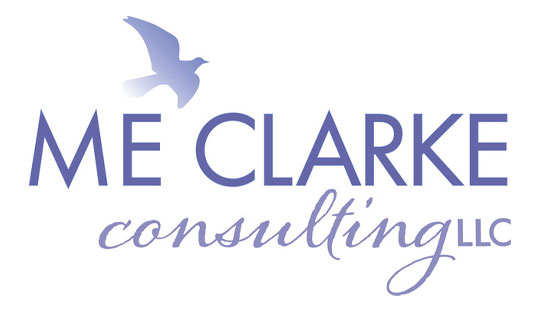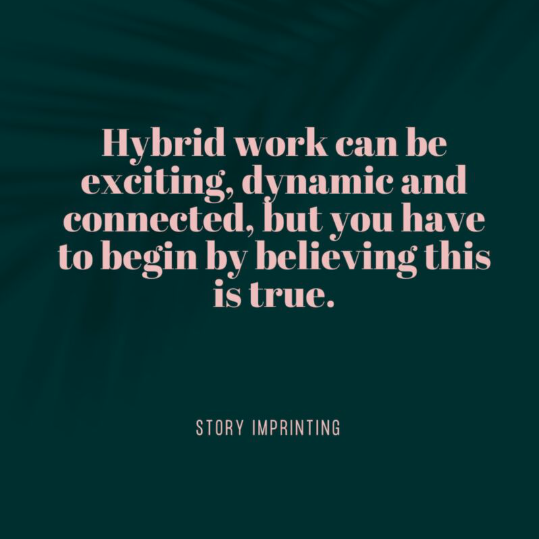Making Hybrid Work
I recently came across this quote from Story Imprinting when perusing LinkedIn. It made me pause and think. I am a firm believer that our thoughts create our beliefs, our beliefs create our actions, and our actions create our reality. Essentially, what comes into our mind and out of our mouth is what comes into our life. I realized I had fallen into a trap of thinking and saying that hybrid is hard. These words reminded me that the first step in making hybrid a success is to begin by believing that it can be successful.
In our line of work, we work with teams and individuals from a variety of organizations and industries. This gives us a bird’s eye view of what’s working (or not) in hybrid, as well as our own learnings convening teams in this environment. Here are a few take-aways of what we’ve seen to be working well in hybrid work.
A large source of frustration about hybrid work? Individuals and teams do not want to commute into the office only to sit on video calls with colleagues who are working remotely. If you’re implementing a hybrid workforce, use coordination and intention to ensure that days in the office have their highest and best use for collaboration and teaming. Teams should be in the office and at home on the same days, or at least share some overlapping days at the office for connection and collaboration.
Hosting a large hybrid meeting or event? Ensure that you have a facilitator who is in the room and a co-facilitator who is joining remotely. This will help ensure that time and attention is given to those in the room and those attending via video call.
Whether a large or small meeting, designate someone as a point of contact for those joining remotely. This creates a single person to chat and troubleshoot if there are audio, visual, or other connectivity issues.
The beauty of remote and hybrid work is that it has created flexibility for how and where we work. For employees this means we can consider working at an organization without uprooting our lives or families. For employers, this means an expanded pool of talented candidates who wouldn’t have previously considered your organization due to the commute, cost of living, and necessary move. The unintended consequence of this set-up as we return to the office or implement hybrid work is that fully remote employees lack the natural connective tissue that is created in-person. This creates the potential for geographic (in)equity. Despite our best efforts, sometimes ‘out of sight is out of mind’ is real. One tip to consider is not to mix your teams when you’re hiring. Think in terms of “apples to apples” by hiring teams that will be fully in-person, hybrid, or fully remote versus an “apples to oranges” approach. This would mean not hiring fully remote employees on teams that are in-person or expected to be hybrid. By the same token, keep fully remote teams remote with the caveat of inviting these folks to come together in-person quarterly or bi-annually to create connection.
To do hybrid well requires intention and clear expectations. Be clear about when folks are expected to be in-person and when they are not. There will be life emergencies that require folks to call-in (and how cool is it that technology evolved so quickly in the pandemic to allow us to do that!?!) but don’t let a standing Teams or Zoom link lurking in the meeting invitation be an ‘excuse’ for folks not to attend in person. When expectations are not clear, resentment will begin to simmer on your team.
If your team or your organization is finding that hybrid work isn’t working, take a close look at what’s really going on. Often it has nothing to do with remote work or hybrid work. Take time to explore and define the problem. Perhaps it is misalignment of goals, lack of clear priorities, or something else unrelated to hybrid or remote work. Take a close look at your organization’s culture. Do you have a culture based on outcomes and productivity? Chances are your employees with thrive in a hybrid culture. If you have a culture of clock-watching that equates performance with sitting at a desk, you may have challenges with successful hybrid work.
Organizations that get this right are destinations for high performers. Doing hybrid well is a competitive advantage in today’s labor market.
Tell us what you think!
What’s working for you? What’s not? What are your pain points? Email us and tell us all about it! A curious question for us, is about OWLs. They were all the rage but we’ve heard mixed feedback about them and have noticed them falling out of favor. We’d love to hear about your experience with them.
Image credit: Story Imprinting (check them out for thought-provoking and insightful content)





Leave a Reply
Want to join the discussion?Feel free to contribute!